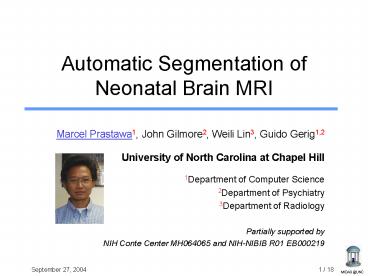Automatic Segmentation of Neonatal Brain MRI - PowerPoint PPT Presentation
Title:
Automatic Segmentation of Neonatal Brain MRI
Description:
3Department of Radiology. Partially supported by ... H ppi et al 1998 (clinical study) T1. T2. T2. T1. Labels. gm. myel. WM. nonm. WM. csf ... – PowerPoint PPT presentation
Number of Views:409
Avg rating:3.0/5.0
Title: Automatic Segmentation of Neonatal Brain MRI
1
Automatic Segmentation of Neonatal Brain MRI
- Marcel Prastawa1, John Gilmore2, Weili Lin3,
Guido Gerig1,2 - University of North Carolina at Chapel Hill
- 1Department of Computer Science
- 2Department of Psychiatry
- 3Department of Radiology
- Partially supported by
- NIH Conte Center MH064065 and NIH-NIBIB R01
EB000219
2
Goal
- Segmentation of brain tissues of newborn infants
from multimodal MRI - Particular interest in the developing white
matter structure - Motivation
- Analysis of growth patterns, study of
neuro-developmental disorders starting at a very
early age
csf
nWM
gm
mWM
3
Imaging the Developing Brain
age
35 weeks
44 weeks
15 months
2 years
adult
Rhesus equiv. 6yrs
4
Challenges
- Smaller head size
- Low contrast-to-noise ratio
- Intensity inhomogeneity
- Motion artifacts
- Division of white matter into
- myelinated and non-myelinated
- regions
- Previous work
- Warfield et al 1998 (methodology)
- Hüppi et al 1998 (clinical study)
T1
T2
Labels
csf
nonm. WM
gm
myel. WM
5
Challenges
Neonate 2 weeks
Adult
CNR 2.9
CNR 6.9
6
Approach
- Non-optimal input data, rely on high level prior
knowledge - Intensity ordering (e.g. in T2W)
- wm-myelinated lt gm lt wm-non-myelinated lt csf
- Aligned spatial priors (brain atlas)
- White matter is considered as one entity
7
Method Overview
Segmentation - Bias correction
Initialization
Refinement
8
Intensity Clustering
- Samples obtained by thresholding atlas priors
- T1 T2 Pr(wm, x)
Overlay - Noisy data, low contrast ? robust techniques
- Two robust estimation techniques
- Minimum Spanning Tree (MST) clustering
- Minimum Covariance Determinant (MCD) estimator
- Obtain initial estimates of intensity
distributions
9
Minimum Spanning Tree Clustering
- Cocosco et al 2003
- Break long edges in MST, example
- Detect multiple clusters while pruning outliers
- Iterative process, stops when cluster feature
locations are in the desired order - Feature location summary value of cluster
intensities
10
Determining Feature Locations
- Need reliable location estimate to find good
clusters - Standard estimates (e.g., mean, median) not
always optimal - Use robust estimator to determine location of a
compact point set in a cluster
Median
Mean
11
Minimum Covariance Determinant
- Rousseeuw et al 1999
- Feature location of MST clusters to determine
ordering? - Smallest ellipsoid that covers at least half the
data - MCD gives robust location estimate
- Example
12
Intensity Clustering Algorithm
- Apply MCD to GM and CSF samples obtain T2
locations - Construct MST from WM samples
- T ? 2
- Repeat until T 1
- Break edges longer than T x (local average
length) - Find largest myelinated WM cluster, where
- T2myel lt T2GM
- Find largest non-myelin. WM cluster, where
- T2GM lt T2non-myel lt T2CSF
- Stop if WM clusters found
- Otherwise, T ? T 0.01
13
Method Overview
Segmentation - Bias correction
Initialization
Refinement
Initial intensity Gaussian PDFs
14
Bias Correction
- Wells et al 1996, van Leemput et al 1999
- Bias RF inhomogeneity and biology
- Images low contrast, histogram is smooth
- Use spatial context, bias is log-difference of
input intensities and reconstructed flat image - Fit polynomial to the bias field (weighted least
squares) - Interleaves segmentation and bias correction
Gaussian intensity PDFs
15
Method Overview
Segmentation - Bias correction
Initialization
Refinement
Bias corrected images Segmentations
16
Refinement
- Previous stage assumes Gaussian intensity
distributions - May have non-optimal decision boundaries due to
overlap - Re-estimate intensity parameters from
bias-corrected images - MST clustering to obtain training data
- Parzen windowing to estimate density
Parzen kernel density estimate
Atlas prior
17
Results 1/2
- UNC Radiology Weili Lin (Siemens 3T head-only)
- UNC-0094
- UNC-0096
Classification
T1
T2
3D
Classification
T1
T2
3D
18
Results 2/2
- Provided by Petra Hüppi (Geneva, Philips 1.5T)
- Geneva-001
- Geneva-002
T2
Classification
T1
3D
T2
Classification
T1
3D
19
Results UNC 0096
Upper row T1, T2w, Tissue labels, registered
atlas Lower row Probabilities for wm-myel, wm,
gm, csf
20
Results UNC 0096
21
Summary
- Automatic brain tissue segmentation of neonatal
MRI - Detects white matter as myelinated and
non-myelinated structures - Makes use of prior knowledge
- Image intensity ordering
- Spatial locations (probabilistic atlas prior)
- To be used in two large UNC neonatal MRI studies
- Silvio Conte Center 125 neonates at risk
- Neonate Twin study (heritability)
- Current focus Validation
22
Acknowledgements
- Elizabeth Bullitt
- Petra Hüppi
- Koen van Leemput
- Insight Toolkit Community
Neoseg v1.0b
23
Validation (in progress)
- A) Semiautomated expert segmentation of a few
cases - Edge-based segmentation
- Level-set evolution
- Manual editing
- Primarily White-gray contour
- B) Simulated MRI data (similar to MNI ICBM)
24
New Probabilistic Atlas for the 2yrs group
14 subjects, aligned, intensity adjusted,
segmented (UNC M. Jomier/Piven/Cody/Gimpel/Gerig)































